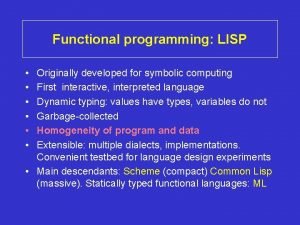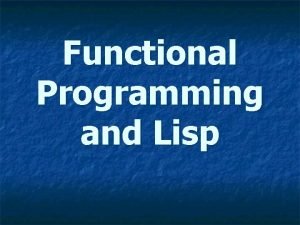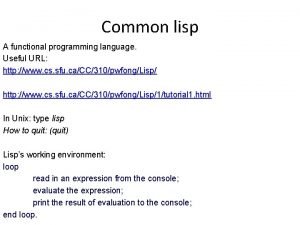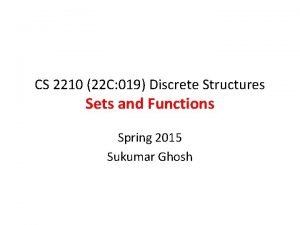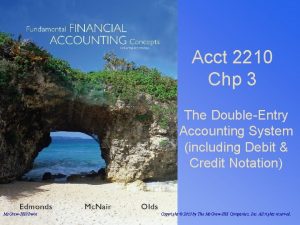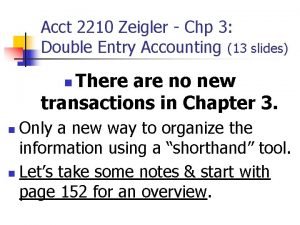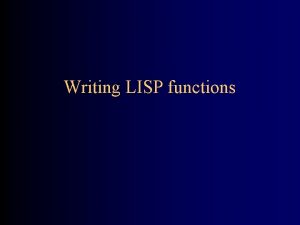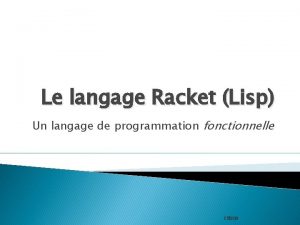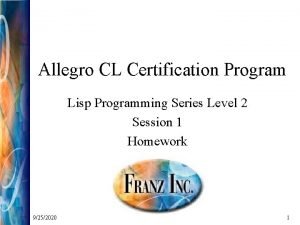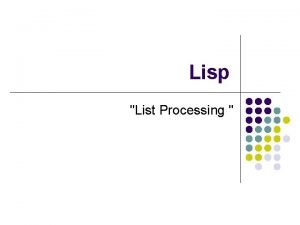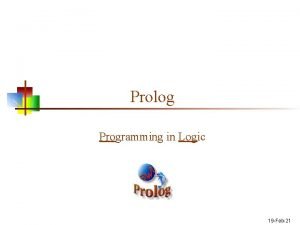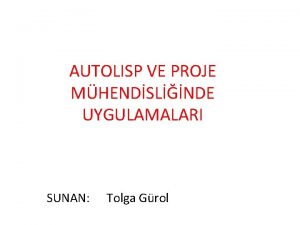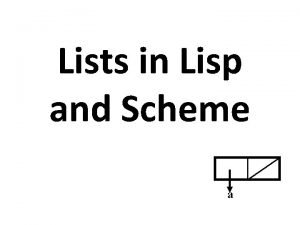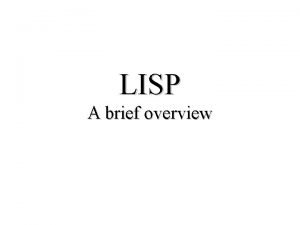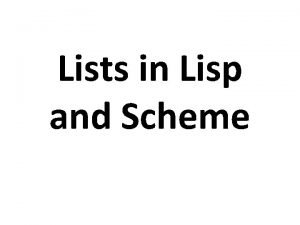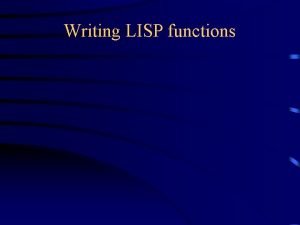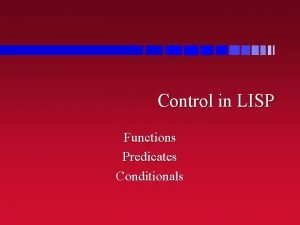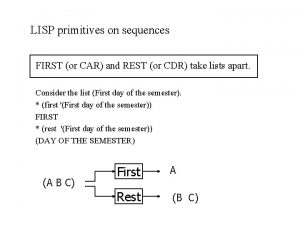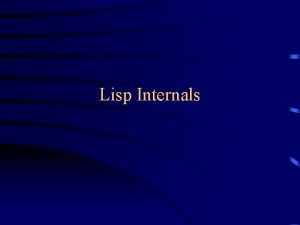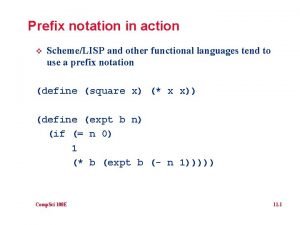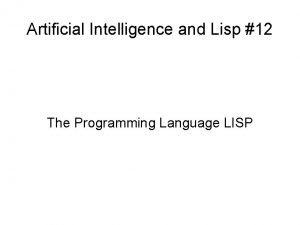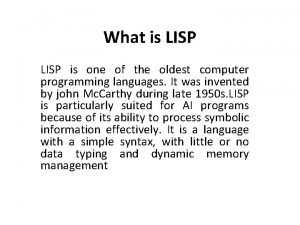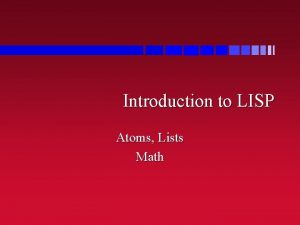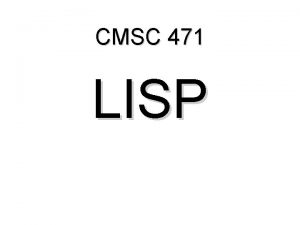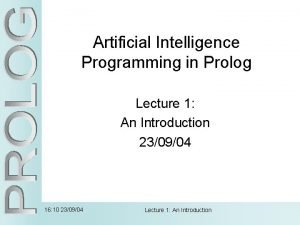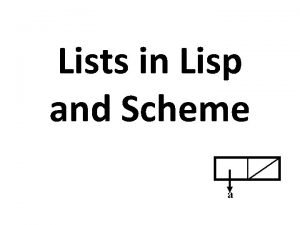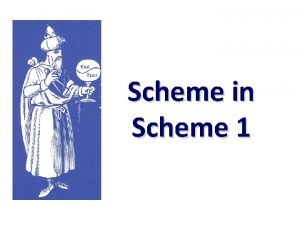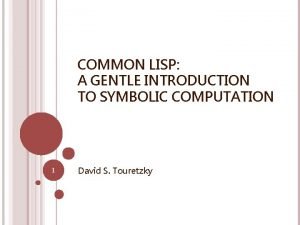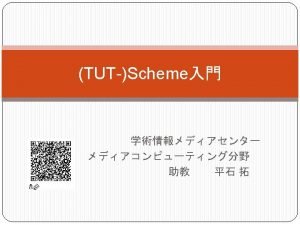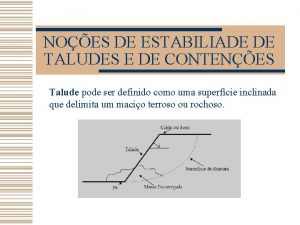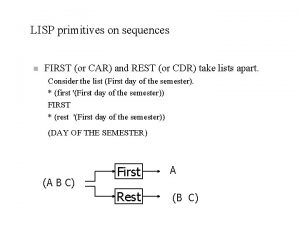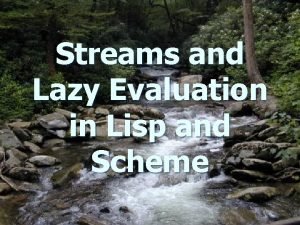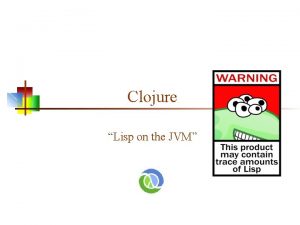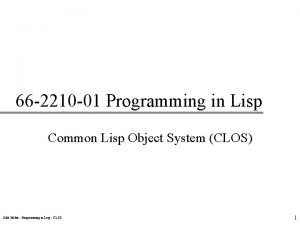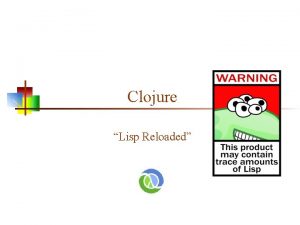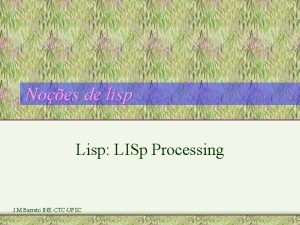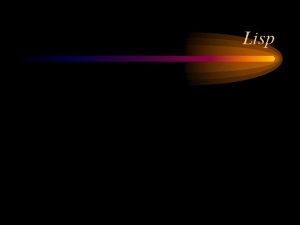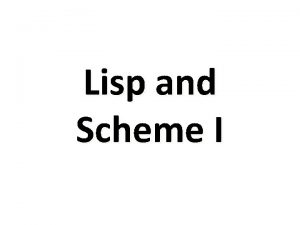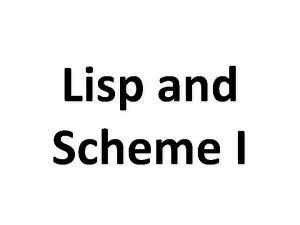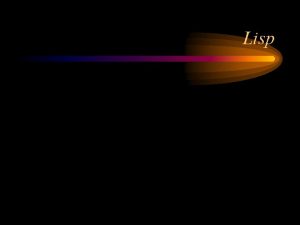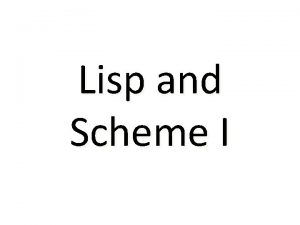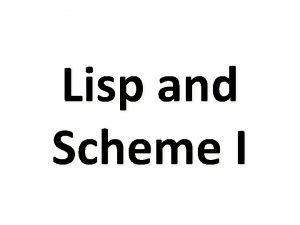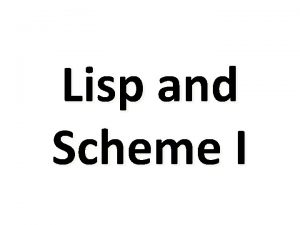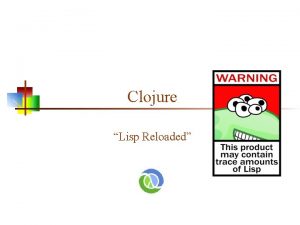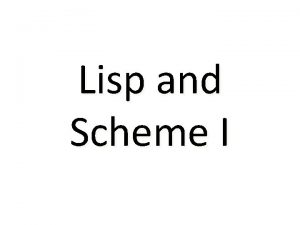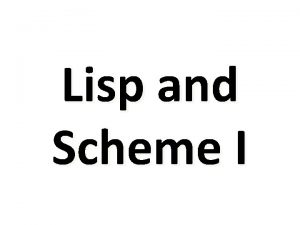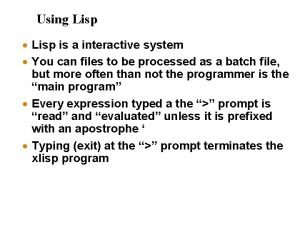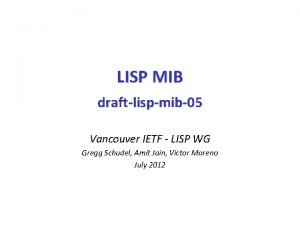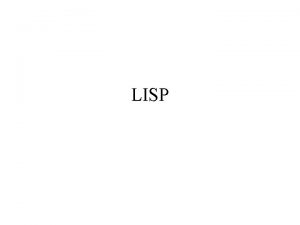CSCI 2210 Programming in Lisp Procedures CSCI 2210









































- Slides: 41

CSCI 2210: Programming in Lisp Procedures CSCI 2210 - Programming in Lisp; Instructor: Alok Mehta 1

Example: Our-third · Function to get the third element of a list > (third '(a b c d e)) c · How can we do this without using THIRD? – Want to create our own function, OUR-THIRD that mimics THIRD > (our-third '(a b c d e)) c – Definition of OUR-THIRD > (defun our-third (x) (first (rest x)))) OUR-THIRD · Many Lisp built-in functions can be written using other Lisp built-in functions · See Appendix B, Lisp in Lisp. CSCI 2210 - Programming in Lisp; Instructor: Alok Mehta 2

Example: Both-ends · Define a procedure that gives both ends of a list > (setf itinerary ’(Albany NYC Chicago Seattle Anchorage)) > (both-ends itinerary) (ALBANY ANCHORAGE) · Three steps · Get first element > (first itinerary) ALBANY · Get last element > (first (last itinerary)) ANCHORAGE · Combine the two > (list (first itinerary) (first (last itinerary))) · Define procedure > (defun both-ends (l) (list (first l) (first (last l)))) CSCI 2210 - Programming in Lisp; Instructor: Alok Mehta 3

Example: Distance · Write a function to find the distance between 2 points. > (defun sqr (x) (* x x)) SQR > (defun distance (x 1 y 1 x 2 y 2) (sqrt (+ (sqr (- x 2 x 1)) (sqr (- y 2 y 1))))) DISTANCE > (setf originx 0 originy 0) 0 > (distance originx originy 2 2) 1. 414 – Must have correct number of arguments – The value of each argument is copied to the corresponding parameter originx originy 2 2 copied to to CSCI 2210 - Programming in Lisp; Instructor: Alok Mehta x 1 y 1 x 2 y 2 4

Scope · Consider > (setf a ’ORIG-A b ’ORIG-B c ’ORIG-C) ORIG-C > (list a b c) (ORIG-A ORIG-B ORIG-C) > (defun myfun (a) (setf a ’myfun-a) (setf b ’myfun-b) (list a b)) > (myfun c) (MYFUN-A MYFUN-B) > (list a b c) (ORIG-A MYFUN-B ORIG-C) A, B, C A · Value of C is copied to A – Parameter passing: Pass by Value (Like C/C++ default) · Global variables are still accessible! – Like C/C++ Global variables · Lexical variable: variable declared as a parameter · Special variable: variable not declared as a parameter CSCI 2210 - Programming in Lisp; Instructor: Alok Mehta 5

Let · Let = Lisp’s way of defining local variables (let ( (<var 1> <value 1>) (<var 2> <value 2>) … ) <expr 1> <expr 2> ) · Example (defun distance (x 1 y 1 x 2 y 2) (let ( (dx (- x 2 x 1)) (dy (- y 2 y 1)) ) (sqrt (+ (sqr dx) (sqr dy))) )) · Let evaluates in parallel (not sequentially) · Uses original values of variables in all (<var> <value>) pairs (let ( (dx (- x 2 x 1)) (dy (- y 2 y 1)) (dx_sqr (sqr dx)) (dy_sqr (sqr dy)) ) (sqrt (+ dx_sqr dy_sqr)) ) CSCI 2210 - Programming in Lisp; Instructor: Alok Mehta ; ; Won’t work! 6

Let vs. Let* · Let - Parallel evaluation > (setf x ’outside) OUTSIDE > (let ((x ’inside) (y x)) (list x y)) (INSIDE OUTSIDE) · Let* - Sequential evaluation > (setf x ’outside) OUTSIDE > (let* ((x ’inside) (y x)) (list x y)) (INSIDE) · Let* Implementation of distance (let* ( (dx (- x 2 x 1)) (dy (- y 2 y 1)) (dx_sqr (sqr dx)) (dy_sqr (sqr dy)) ) (sqrt (+ dx_sqr dy_sqr)) ) CSCI 2210 - Programming in Lisp; Instructor: Alok Mehta ; ; OK! 7

Exercise · 1. Rewrite the distance function to use “setf” instead of “let”. Explain the difference. · 2. Write the function solve-quadratic such that, given a, b, c, the function finds all values of x for which ax^2 + bx + c = 0. x 1 = (-b + sqrt (b^2 - 4 ac)) / 2 a x 2 = (-b - sqrt (b^2 - 4 ac)) / 2 a The function should return both values of x as a list of two elements. For example, > (solve-quadratic 1 -2 1) (1. 0) CSCI 2210 - Programming in Lisp; Instructor: Alok Mehta 8

Example: Solve-quadratic · Solution to solve-quadratic (defun solve-quadratic (a b c) (let ((sqrt_clause (- (* b b) (* 4 a c))) (neg_b (- b)) (two_a (* 2 a)) ) (list (/ (+ neg_b (sqrt_clause)) two_a) (/ (- neg_b (sqrt_clause)) two_a)))) · Notes - No error checking is done · (- (* b b) (* 4 a c)) might result in a negative number – What happens when you try to take sqrt of a negative number? · What happens when the value of A is zero? · Need · Predicates - to determine when error conditions occur (e. g. =) · Conditionals - to do something else when error occurs CSCI 2210 - Programming in Lisp; Instructor: Alok Mehta 9

EQUAL does not = EQL · Several predicates check equality · Slightly different semantics – Can be confusing · Equality predicates · · Equal - Are two argument values the same expression? Eql - Are two argument values the same symbol or number? Eq - Are two argument values the same symbol? = - Are two argument values the same number? · General Rule of Thumb · Use = when you want to compare numbers · Use EQUAL otherwise CSCI 2210 - Programming in Lisp; Instructor: Alok Mehta 10

Relationships Bet Equality Pred’s F A = D B C E EQ EQL EQUAL · EQ vs. = · = returns T if two numbers are the same, regardless of their type · EQ returns T if two arguments are the same symbol – Same chunk of memory – Identical primitives sometimes are EQ · Examples > > (eq (eq 4 4) (/ 1 4) 0. 25) ’A ’A) 4. 0) ; ; ; ; EQ: T EQ: NIL CSCI 2210 - Programming in Lisp; Instructor: Alok Mehta =: T (C) =: T (A) =: Error (D) =: T (A) 11

EQL vs. = · EQL · Arguments are EQL if they are either EQ or they are equivalent numbers of the same type · Examples > (eq 4. 0) > (eq 4 4. 0) ; ; EQ: NIL EQL: T =: T (B) ; ; EQ: NIL EQL: NIL =: T (A) · EQUAL · Arguments are EQUAL if they are either EQL or they are Lists whose elements are EQUAL · Performs an element by element comparison of lists CSCI 2210 - Programming in Lisp; Instructor: Alok Mehta 12

EQUAL vs. EQL vs. = C · EQUAL vs. EQL > (setf X ’(A (B (C)))) > (setf Y X) > (setf Z ’(A (B (C)))) · X and Y are EQUAL and EQL · X and Z are EQUAL but not EQL – They don’t point to the SAME memory – But, if you do an element by element comparison of the lists, they are equal B A X B · EQUAL vs. = > (EQUAL 4 4. 0) NIL > (= 4 4. 0) T CSCI 2210 - Programming in Lisp; Instructor: Alok Mehta C Y A Z 13

Data Type Predicates · Compare objects to determine their type – atom - Is argument an atom? – numberp - Is argument a number? – symbolp - Is argument a symbol (a non-numeric atom)? – listp - Is argument a list? · Examples > (list pi ’ABC) (3. 14159 ABC) > (list (atom pi) (atom ’ABC)) (T T) > (list (numberp pi) (numberp ’ABC)) (T NIL) > (list (symbolp pi) (symbolp ’ABC)) (NIL T) > (listp pi) (listp ’ABC) (listp ’(A B)) (NIL T) CSCI 2210 - Programming in Lisp; Instructor: Alok Mehta 14

Number Predicates · Number predicates · · · · numberp - Is it a number? zerop - Is it zero? Argument must be a number plusp - Is it positive? Argument must be a number minusp - Is it negative? Argument must be a number evenp - Is it even? oddp - Is it odd? > - Is the list of arguments in descending order? (e. g. (> 5 4)) < - Is the list of arguments in ascending order? CSCI 2210 - Programming in Lisp; Instructor: Alok Mehta 15

If, When, Unless · If · (if <test> <then-form> <else-form>) · if <test> is true – <then-form> is evaluated, – otherwise <else-form> is evaluated. · When · (when <test> <then-form 1> <then-form 2> …) · If <test> is true, then other arguments are evaluated. · Unless · (unless <test> <else-form 1> <else-form 2> …) · If <test> is false, then other arguments are evaluated. CSCI 2210 - Programming in Lisp; Instructor: Alok Mehta 16

Cond · Cond format (COND (<test 1> (<test 2> (<test 3> … (<testi> … (<testm> <then-1 -1> <then-1 -2> …) <then-2 -1> <then-2 -2> …) <then-3 -1> <then-3 -2> …) <then-i-1> <then-i-2> …) <then-m-1> <then-m-2> …) · Semantics · 1. Evaluate <test 1>, <test 2>, … until you get to a <testi> such that <testi> evaluates to a non. NIL value · 2. Evaluate <then-i-1> <then-i-2> … · 3. Return value of the last <then-i-n> clause executed · If all tests evaluate to NIL, result of COND is NIL CSCI 2210 - Programming in Lisp; Instructor: Alok Mehta 17

Example · Define a function to find area (defun area (type r) (cond ((equal type ’circle) (* ((equal type ’sphere) (* ((equal type ’square) (* ((equal type ’cube) (* 6 ( t (print “Error”) )) PI R R)) 4 PI R R)) · Define a function, compute-grade, to determine the letter grade. (compute-grade 81. 5) B CSCI 2210 - Programming in Lisp; Instructor: Alok Mehta 18

Case · Similar to COND, but is more elegant when checking for equality (defun area (type r) (case type (circle (* PI R R)) (sphere (* 4 PI R R)) (square (* R R) (cube (* 6 R R)) (otherwise (print “Error”) )) · Format (case <key-form> (<key 1> <then-1 -2> …) (<key 2> <then-2 -1> <then-2 -2> …) … (<key m> <then-m-1> <then-m-2> …) (otherwise <then-o-1> <then-o-2> …) CSCI 2210 - Programming in Lisp; Instructor: Alok Mehta 19

Case (2) · Notes · <key-form> is evaluated – But, <key 1> <key 2>, … are NOT evaluated · “OTHERWISE” or “T” always evaluate to non. NIL · If no matches are found, the CASE statement returns NIL · A <key> form may contain a list. In this case, the <key-form> can match ANY element of the list (defun circularp (type) (case type ((circle sphere) ’T) (otherwise NIL))) (circularp ’cube) – Technical note: the MEMBER function is used to do the comparison. CSCI 2210 - Programming in Lisp; Instructor: Alok Mehta 20

Both-ends Revisited · Both-ends with error handling (defun both-ends (l) (if (listp l) (case (length l) (0 NIL) (1 (list (first l))) (t (list (first l) (first (last l))))) NIL)) CSCI 2210 - Programming in Lisp; Instructor: Alok Mehta 21

Solve-quadratic revisited · Solve-quadratic with error checking · Checks for errors; returns NIL instead (defun solve-quadratic (a b c) (if (not (and (numberp a) (numberp b) (numberp c))) NIL ; at least one argument is not a number (let ((sqrt_clause (- (* b b) (* 4 a c))) (neg_b (- b)) (two_a (* 2 a)) ) (cond ((minusp sqrt_clause) NIL) ((= 0 a) NIL) ; Could have used zerop (t (list (/ (+ neg_b (sqrt_clause)) two_a) (/ (- neg_b (sqrt_clause)) two_a))))))) · What happens if we don't include the clause (minusp sqrt_clause) … – By default, Lisp arithmetic operations handle complex numbers CSCI 2210 - Programming in Lisp; Instructor: Alok Mehta 22

Factorial · Definition of Factorial · C++ Implementation int factorial (int x) { int i, f; f = 1; for (i=1; i<=x; i++) f = f * i; return f; } · Lisp Implementation (defun factorial (n) (let ((f 1)) (dotimes (i n f) (setf f (* f (+ i 1)))))) – Note: To more easily compare, C++ loop could have been written as: for (i=0; i<x; i++) f = f * (i + 1); · Tip: Compute factorial(100) using C/C++ and Lisp CSCI 2210 - Programming in Lisp; Instructor: Alok Mehta 23

Do. Times · DOTIMES is Lisp’s way of doing iteration · C/C++ for (i=0; i<n; i++) { <body> } · Lisp (dotimes (i n) <body>) · First parameter is a list with three elements – counter variable (e. g. i) – number of times to iterate (e. g. n) · Counter variable (i) ranges from 0 to n-1 · Optional return value can be specified (default is NIL) (dotimes (i n return_value) <body>) CSCI 2210 - Programming in Lisp; Instructor: Alok Mehta 24

Recursively Calculating Factorial · Mathematical Definition of Factorial · C/C++ Implementation long Factorial (long X) { if (X <= 1) return 1; else return X * Factorial(X-1); } · Lisp Implementation (defun recursive-factorial (x) (if (<= x 1) 1 (* x (recursive-factorial (- x 1))))) CSCI 2210 - Programming in Lisp; Instructor: Alok Mehta 25

Recursive calls · Show recursion when calling (recursive-factorial 4) Begin (recursive-factorial 4) Since 4>1, evaluate 4 * (recursive-factorial 3) Begin (recursive-factorial 3) Since 3>1, evaluate 3 * (recursive-factorial 2) Begin (recursive-factorial 2) Since 2>1, evaluate 2*(recursive-factorial 1) Begin (recursive-factorial 1) Since 1<=1, return 1 End (recursive-factorial 1), returns 1 2 * (recursive-factorial 1) = 2 * 1 = 2 End (recursive-factorial 2), returns 2 3 * (recursive-factorial 2) = 3 * 2 = 6 End (recursive-factorial 3), returns 6 4 * (recursive-factorial 3) = 4 * 6 = 24 End (recursive-factorial 4), returns 24 CSCI 2210 - Programming in Lisp; Instructor: Alok Mehta 26

MEMBER · Checks if first argument is an element of second argument · Returns what is left of the list when symbol is found > (setf sentence ’(tell me more about your mother please)) (TELL ME MORE ABOUT YOUR MOTHER PLEASE) > (member ’mother sentence) (MOTHER PLEASE) · Only checks the top level for a match (using EQL) > (member ’mother ’((father son) (mother daughter))) NIL CSCI 2210 - Programming in Lisp; Instructor: Alok Mehta 27

Example: Our-member · Our-Member (defun our-member (obj a. List) (if (null a. List) nil (if (eql (first a. List) obj) a. List (our-member obj (rest a. List))))) · This "design pattern" is used frequently in Lisp for recursive methods that operate on Lists (defun <recursive-function (a. List) (if <base condition> <terminate with return value> <process first element> <recursively process everything except the first element>)) CSCI 2210 - Programming in Lisp; Instructor: Alok Mehta 28

MEMBER; Keyword Modifiers · MEMBER tests for membership using EQL > (setf pairs ’((maple shade) (apple fruit))) > (first pairs) (MAPLE SHADE) > (member (first pairs) ((MAPLE SHADE) (APPLE FRUIT)) > (member ’(maple shade) pairs) NIL · Use keyword modifier to override > (member ’(maple shade) pairs : test #’equal) ((MAPLE SHADE) (APPLE FRUIT)) · : test is a keyword; it expects an argument of type procedure · #’equal is a keyword argument – #’ is a macro – #’equal expands to (function equal) – Returns the procedure object named “equal” CSCI 2210 - Programming in Lisp; Instructor: Alok Mehta 29

Keywords; Procedure Macro · Why use keywords? · Why not just an optional parameter? > (member ’(maple shade) pairs #’equal) · Keywords allow more than one type of behavior modification – : test-not is another keyword for MEMBER · Why use procedure objects? · Why not just allow procedure name to be passed? > (member ’(maple shade) pairs : test equal) · Procedure objects can be bound to variable names > (setf predicate #’equal) > (member ’(maple shade) pairs : test predicate) · Can pass them as parameters to functions, etc. CSCI 2210 - Programming in Lisp; Instructor: Alok Mehta 30

Recursive Definition of Length · Length (defun mylength (l) (if (endp l) 0 (+ 1 (mylength (rest l))))) · Alternate definition (defun mylength 2 (l) (mylength 2 -aux l 0)) (defun mylength 2 -aux (l count) (if (endp l) count (mylength 2 -aux l (+ count 1)))) · Note · All recursive calls simply return the final value evaluated. · No additional computations CSCI 2210 - Programming in Lisp; Instructor: Alok Mehta 31

Tail Recursion · The final expression of a function is a recursive call · No additional computations are done to that expression – That is, return value is JUST the result of the recursive call · Lisp handles tail recursion efficiently · Mylength is not tail recursive · Mylength 2 is tail recursive · Example: · Write a function to produce N atoms with value ‘A’. > (produce-list-of-a 5) ; Example call (A A A) CSCI 2210 - Programming in Lisp; Instructor: Alok Mehta 32

Produce-list-of-a · Using dotimes (defun produce-list-of-a (n) (let ((la NIL)) (dotimes (i n la) (push 'A la)))) · Recursion, not tail recursive (defun produce-list-of-a (n) (if (= n 0) nil (cons 'A (produce-list-of-a (- n 1))))) · Recursion, with tail recursion (defun produce-list-of-a (n) (produce-list-of-a-aux n NIL)) (defun produce-list-of-a-aux (n list-so-far) (if (= n 0) list-so-far (produce-list-of-a-aux (- n 1) (cons 'A list-so-far)))) CSCI 2210 - Programming in Lisp; Instructor: Alok Mehta 33

Tower of Hanoi · · Three pegs, S(start), T(temp), E(end) N disks Goal: Move disks from peg S to peg E Restriction: Larger disk can’t be placed on top of smaller disk S T E CSCI 2210 - Programming in Lisp; Instructor: Alok Mehta 34

Tower of Hanoi · Solution to Tower of Hanoi (defun hanoi-aux (n start end temp) (if (> n 1) (hanoi-aux (- n 1) start temp end)) (print (list start end)) (if (> n 1) (hanoi-aux (- n 1) temp end start))) (defun hanoi (n) (hanoi-aux n 'S 'E 'T)) · Example Runs > (hanoi 2) (S T) (S E) (T E) NIL CSCI 2210 - Programming in Lisp; Instructor: Alok Mehta > (hanoi 3) (S E) (S T) (E T) (S E) (T S) (T E) (S E) NIL 35

&Optional · Produce-list-of-a function(s) (defun produce-list-of-a (n) (produce-list-of-a-aux n NIL)) (defun produce-list-of-a-aux (n list-so-far) (if (= n 0) list-so-far (produce-list-of-a-aux (- n 1) (cons 'A list-so-far)))) · Redefined with optional parameters (defun produce-list-of-a (n &optional list-so-far) (if (= n 0) list-so-far (produce-list-of-a (- n 1) (cons 'A list-so-far)))) · Note: optional values are bound to NIL, by default CSCI 2210 - Programming in Lisp; Instructor: Alok Mehta 36

Optional Parameters (cont) · Solution to Hanoi (defun hanoi-aux (n start end temp) (if (> n 1) (hanoi-aux (- n 1) start temp end)) (print (list start end)) (if (> n 1) (hanoi-aux (- n 1) temp end start))) (defun hanoi (n) (hanoi-aux n 'S 'E 'T)) · Revised with optional parameters (defun hanoi (n &optional (start 'S) (end 'E) (temp 'T)) (if (> n 1) (hanoi (- n 1) start temp end)) (print (list start end)) (if (> n 1) (hanoi (- n 1) temp end start))) · Note: notice the syntax for initializing optional parameters CSCI 2210 - Programming in Lisp; Instructor: Alok Mehta 37

&Rest · &Rest - Specifies a variable number of arguments · Example: Assume + only accepts 2 arguments. Define “Plus”, a function that adds an arbitrary number of arguments) > (plus 2 3 4 5 8) · Solution (defun plus (arg 1 &rest other_args) (plus-aux arg 1 other_args)) (defun plus-aux (arg 1 other_args) (if (null other_args) arg 1 (plus-aux (+ arg 1 (first other_args)) (rest other_args)))) CSCI 2210 - Programming in Lisp; Instructor: Alok Mehta 38

Key Parameters · KEYword parameter · Useful when function has MANY parameters · Most are tied to default values · Examples > (rotate-list (E A B C D) > (rotate-list (B C D E A) > (rotate-list (D E A B C) > (rotate-list (C D E A B) '(a b c d e)) ; rotate one element right '(a b c d e) : direction 'left) '(a b c d e) : distance 2) '(a b c d e) : direction 'left : distance 2) CSCI 2210 - Programming in Lisp; Instructor: Alok Mehta 39

&Key · Use &key to define Key parameters (defun rotate-list (l &key (direction 'right) (distance 1)) (if (eq direction 'left) (rotate-list-left l distance) (rotate-list-right l distance))) (defun rotate-list-right (l n) (if (zerop n) l (rotate-list-right (append (last l) (butlast l)) (- n 1)))) (defun rotate-list-left (l n) (if (zerop n) l (rotate-list-right (append (rest l) (list (first l))) (- n 1)))) CSCI 2210 - Programming in Lisp; Instructor: Alok Mehta 40

&Aux · &Aux keyword is used as a shorthand for Let* · Produce-list-of-a using Let* (defun produce-list-of-a (n) (let* ((la NIL)) (dotimes (i n la) (push 'A la)))) · Using &Aux (defun produce-list-of-a (n &aux (la NIL)) (dotimes (i n la) (push 'A la))) CSCI 2210 - Programming in Lisp; Instructor: Alok Mehta 41
 Lisp functional programming
Lisp functional programming Lisp functional programming
Lisp functional programming Is lisp a functional programming language
Is lisp a functional programming language Cs 2210
Cs 2210 Acct 2210
Acct 2210 Acct 2210
Acct 2210 Physics 2210
Physics 2210 Runtime programming
Runtime programming Linear vs integer programming
Linear vs integer programming Perbedaan linear programming dan integer programming
Perbedaan linear programming dan integer programming Perbedaan linear programming dan integer programming
Perbedaan linear programming dan integer programming Greedy vs dynamic
Greedy vs dynamic Lisp unless
Lisp unless Clojure language
Clojure language Lisp interpreter
Lisp interpreter Rotatef lisp
Rotatef lisp Lisp list processing
Lisp list processing Lisp and prolog
Lisp and prolog Autocad lisp nedir
Autocad lisp nedir Positive list scheme
Positive list scheme Lisp stands for
Lisp stands for Common lisp association list
Common lisp association list Scheme append to list
Scheme append to list Lisp cond
Lisp cond Lisp conditionals
Lisp conditionals Lisp car
Lisp car Cons in lisp
Cons in lisp Prefix postfix
Prefix postfix Lisp examples
Lisp examples Lisp program to find factorial of a number
Lisp program to find factorial of a number Lisp atom
Lisp atom Xkcd lisp
Xkcd lisp Lisp and prolog
Lisp and prolog Positive list scheme
Positive list scheme Cons in lisp
Cons in lisp Common lisp a gentle introduction to symbolic computation
Common lisp a gentle introduction to symbolic computation Lisp provider
Lisp provider Emacs scheme
Emacs scheme Retaludamento
Retaludamento Butlast lisp
Butlast lisp Snull
Snull Lisp vs clojure
Lisp vs clojure
